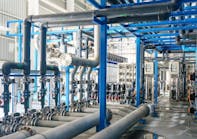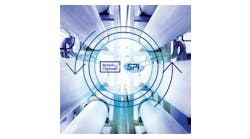The water pump purchasers and water pump end users realize the value and the payback of an accurate and high-quality shop performance test and shop mechanical run test. The procedures and methods to correctly implement a shop performance test of water pumps are discussed in this article. A test with the similar liquid and operating conditions should be done wherever possible. Otherwise, the arrangement and details of performance test, as close to the specified operating condition as possible, should be fixed before the water pump order. All these details related to the water pump performance test are described in this article.
It is difficult to modify a water pump and correct the design or fabrication errors in the job site. Comprehensive shop tests are always recommended to minimize the site modifications. The shop test is the first test after completion of the manufacturing of a water pump and the last test before the water pump delivery. The careful analysis of the shop test results can help to detect malfunctions (or deviations) before the water pump delivery. Any correction or modification in the site (after the delivery of water pump) needs expensive and special considerations.
The settings of various control/monitoring instruments (or sensors) of water pumping system is often the subject of considerable debate. Although certain guidelines can be set up to predict what levels of various parameters are acceptable, a good source of the performance data could be the shop performance tests.
Performance test procedure
The safe operating speed, pump critical speeds, maximum allowable pressures, allowable temperatures and other pump limits should be considered in the shop test procedure and test condition selection. An alternative arrangement of the shop test may result in considerable deviations from the test conditions (compared to the job site). There is always a question regarding the accuracy and usefulness of water pump shop performance tests with an alternative condition.
The arrangement and details of the shop performance test should preferably be fixed in the bidding stage and particularly before the water pump order. The water pump manufacturers usually prefer the simplest and cheapest arrangement for the shop performance test. Unfortunately, the shop performance test arrangement and details are discussed after the water pump order or even near the test time; it usually causes considerable change in order costs or a poor shop performance test arrangement.
For the shop performance test, the following limits should be respected:
- The head and the capacity: Usually zero negative tolerance.
- The power: Not exceeding 104 percent of the predicted power. Sometimes when the water pumping system efficiency is critical, a lower limit (as low as two percent) may be adopted and agreed upon before the water pump order.
The complete water pump train shop test is always recommended (if practical). All water pump train components including water pump casings, the gear unit, the driver and all auxiliaries should be tested all together. If complete water pump unit test is not possible, a tandem test is useful. In the tandem test, usually a shop driver, a shop oil system and other shop facilities are used. A separate auxiliary test may be performed in this case. The torsional vibration measurements are recommended for the modern large water pumps to evaluate torsional calculations; it is necessary for the complex multi-machine water pump trains including the gear unit(s) or the variable-speed driver.
Shop test arrangement
The pre-test run is strongly recommended for any water pump. The water pump train should be operated for the sufficient time to demonstrate an acceptable mechanical operation, to confirm all instruments are functioning and the stable values of all measurements. The preliminary and pre-test data are always useful. The shop test stand considerations are:
- The pressure safety valves for an accidental overpressure
- The requirements of alarms and automatic shutdowns, such as low oil pressure, pump over-speed and other possible malfunctions.
Generally, water pump performance curves at shop performance tests are required to verify the complete range of operation of the water pump (multi-point test). Usually, a minimum of six points are required to complete a pump curve. As a rough indication, the shutoff point, 50 percent of rated point, 75 percent of rated point, the rated point (100 percent) and 120 percent of rated point should be included.
The shop mechanical running test should include the oil system performance, bearing operation, seal performance and vibration conditions. The real-time vibration data (from the start-up to the shutdown) should be recorded and properly evaluated.
Shop test measurements
The variable speed drivers are usually used for water pump shop tests. The continuous indication of the speed fluctuation is also required. The use of two independent speed instruments, one to provide a check on the other, is recommended. The digital speed indicator (generally with an accurate around 5 rpm) and an additional key-phasor system are usually used.
The shaft power input at water pump coupling or the drive shaft can be measured by:
- The torque-meters or the reaction mounted drivers. The torque can be directly measured by devices installed in a drive shaft interposed between the driver and water pump. The torque-meters for the shop test should be of a type suitable for a proper calibration.
- The power can be computed from the measurements of the electrical input to the electrical motor terminals under certain conditions, such as water pump power requirement above the mid-point of the electric motor rating, losses/efficiencies should be computed and other provisions. The efficiency determination by input-output measurements may not be practical for large electric motors. For the large electric motors, the loss method may be used. The segregated losses of an induction electric motor should include friction losses, windage loss, core loss, I2R losses (of the rotor and the stator) and other losses.
Results of the test calculations are subject to error caused by inaccuracies of test instruments. It is recommended that an uncertainty analysis be made prior to the shop test to assure that the test objectives can be met. The instrument errors on the main shop test parameters (flow, head and power) are usually less than one to three percent employing modern instrument technologies.
Gear-unit shop test
Nowadays, many water pump trains use a gear unit for the speed match. An important part of a water pump train shop test is the shop test of the gear unit. The contract bearings should be used in the gear unit mechanical running test. The gear unit should be operated at the maximum continuous speed until the bearing temperatures and the lubrication oil temperatures have stabilized. Then, the gear unit is operated at 110 percent of the maximum continuous speed for a minimum of 15 minutes. To verify the lateral critical speeds, the speed is momentarily increased to 120 percent of the maximum continuous speed, and the phase amplitude plots are made as the unit coasts down to 10 percent of the maximum continuous speed (bearing temperatures may increase measurably during this action). The gear unit should be operated at the maximum continuous speed for some times (say one to four hours). One of main concerns is the shaft axial vibration particularly for double-helical gear units (usually the limit is around 40-120 μm). Varying the lubrication oil inlet pressures and temperatures within operating limits is always recommended for large water pumps which use forced lubrication oil systems. After the shop test is completed, the gear unit casing cover should be removed and the gear tooth meshes are visually checked and evaluated. The main focuses are on the suitable contact patterns and any damage. The hydrodynamic bearings of the large gear units (and large water pumps) should also be removed, inspected and reassembled.
Site considerations
Care should be taken when designing the team which represents the water pump purchaser for water pump shop tests. Some of the individuals, who attend the water pump shop test, need to be worked at site for the water pump commissioning and at least one for the long-term water pump operation.
There are many notes about necessity of the vendor representative involvement in the water pump piping check and the water pump alignment inspection. Based on experience, it may be useful that the vendor representative observes a check of the water pump piping. On the other hand, it is usually unnecessary to ask the vendor representative to be involved in the initial alignment check or to check the water pump alignment at operating temperatures.
As soon as possible, a site performance test should be conducted on each water pump (after the installation and pre-commissioning). The site performance test procedure is necessary and some extra instruments and temporary provisions may be required. The test should confirm, as a minimum, that the water pump can meet guarantees of the flow, pressure and power and that the other points on the pump curve are within certain limit (ideally +/- five percent) of the shop performance test curve.
Site performance tests may also be implemented during the operation (for example, after several years of operation), to identify the extent of the water pump train degradation.
Conclusion
The water pump shop performance test and the shop mechanical run test are unique opportunities to evaluate water pumps before the delivery to site. The shop performance test is a complex and critical test, and needs special details and considerations. The shop test using the job site operating conditions are always preferred.


